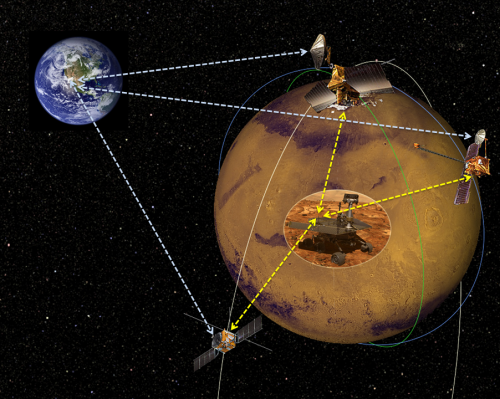NASA seeks proposals for commercial Mars data relay satellites

NASA has issued a Request for Information (RFI) to investigate the possibility of using commercial Mars-orbiting satellites to provide telecommunications capabilities for future robotic missions to the Red Planet.
"We are looking to broaden participation in the exploration of Mars to include new models for government and commercial partnerships," said John Grunsfeld, associate administrator of NASA's Science Mission Directorate at the agency's headquarters in Washington. "Depending on the outcome, the new model could be a vital component in future science missions and the path for humans to Mars."
The RFI details possible new business models that would involve NASA contracting to purchase services from a commercial service provider, which would own and operate one or more communication relay orbiters. The solicitation is open to all types of organizations including U.S. industry, universities, nonprofits, NASA centers, and federally funded research and development centers, in addition to U.S. government and international organizations.
NASA is interested in exploring alternative models to sustain and evolve its Mars' communications relay infrastructure to avoid a communications gap in the 2020s. The RFI encourages innovative ideas for cost-effective approaches that provide relay services for existing landers, as well as significantly improving communications performance.
One possible area for improvement is laser or optical communications. NASA successfully demonstrated laser communications technology in October 2013 with its Lunar Atmosphere and Dust Environment Explorer (LADEE) mission. LADEE made history using a pulsed laser beam to transmit data over 239,000 miles from the moon to Earth at a record-breaking download rate of 622 megabits-per-second (Mbps).
Mars landers and rovers currently transmit their science data and other information to Earth either by a direct communication link or via orbiting satellites acting as relay stations. The direct link is severely limited because of mass, volume, and power limits on the rovers. To address these limits, NASA's Mars Exploration Program currently uses relay radios on its Mars science orbiters. The spacecraft carry high-gain antennas and higher power transmitters that provide very high-rate, energy-efficient links between orbiters and surface missions as the orbiters pass overhead.
NASA currently is operating two Mars science orbiters with relay capabilities—Odyssey, launched in 2001, and the Mars Reconnaissance Orbiter (MRO), launched in 2005. These spacecraft enable communication links from the Curiosity and Opportunity rovers on Mars' surface. This approach will continue with the Sept. 21 arrival of the Mars Atmosphere and Volatile EvolutioN (MAVEN) spacecraft, and the 2016 arrival of the European Space Agency's ExoMars/Trace Gas Orbiter.
"This Mars relay strategy has been extremely successful in providing the science and engineering data returned from the Martian surface over the past decade," said Lisa May, lead program executive for Mars Exploration Program in Washington.
Because NASA has launched science orbiters to Mars on a steady cadence, the current strategy has been cost effective. However, NASA has no scheduled Mars science orbiters after MAVEN arrives on the Red Planet in the fall. This creates the need to identify cost-effective options to ensure continuity of reliable, high-performance telecommunications relay services for the future.
"Looking ahead, we need to seriously explore the possibility of the commercialization of Mars communications services," said May. "This will offer advantages to NASA, while also providing appropriate return-on-investment to the service provider."
Provided by NASA



















